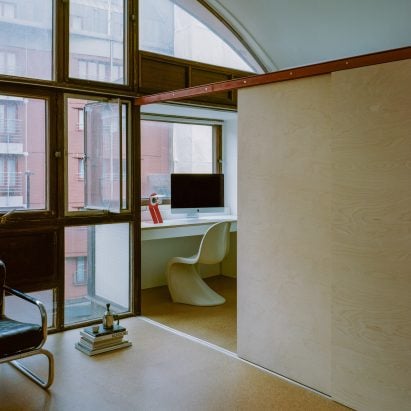A series of demountable sliding screens carve out space in this Crescent House flat, renovated by local architecture studio TYPE on one of London’s most celebrated post-war housing estates.
TYPE‘s overhaul aims to celebrate the architecture of the studio apartment on the Golden Lane Estate – a housing complex in the City of London designed by the Barbican Estate architects Chamberlin, Powell and Bon.
TYPE has renovated a flat inside Crescent House on Golden Lane Estate
The 45-square-metre studio is located on the third floor of Crescent House, a low-rise block at the estate that follows the curve of Goswell Road and is listed as Grade II* for its special architectural interest.
Constructed in the 1960s, the building features a facade of bush-hammered concrete, arched concrete lintels and timber windows influenced by Maisons Jaoul, a pair of 1950s houses in France by Le Corbusier.
It has been designed to celebrate the existing architecture
Inside, the Crescent House flat has a barrelled ceiling and distinctive windows that have been retained, while other original details have been uncovered having previously been “lost to a layer of clutter”.
“Uncovering and celebrating the existing architecture became our starting point for the project,” said TYPE director Ogi Ristic, who owned the apartment with his partner when the renovation took place.
A series of screens have been introduced
One of the studio’s aims was to adapt the open-plan space to create separate zones for living, dining and sleeping while working within the confines of the building’s heritage status.
It also needed retrofitting, as it had not been refurbished since it was built and had little to no insulation, with significant damp and condensation issues.
The screens create separate zones for living, dining and sleeping
The City of London – the local authority which manages the Golden Lane Estate – told the architect that the flat’s original layout could not be modified. However, TYPE’s proposal to divide the space up using demountable sliding screens was approved.
According to the studio, the screens were designed “in the spirit” of Chamberlin, Powell and Bon’s original designs for Crescent House, which included an unrealised idea to use partitions to create dressing room areas.
“Though a simple move, the screens were pivotal to opening the flat up to more flexible uses than had been originally envisaged, whilst making it feel larger and more spacious,” said Ristic.
The screens are made of veneered honeycomb cardboard, chosen as they are low-cost and recyclable. Other materials used in the renovation include cork floors in place of the worn-out carpet and Ecoboard – panels made from biomaterials – in place of MDF for kitchen cabinetry and joinery.
TYPE’s design responds to the confines of the building’s heritage status
The block in which the flat is located was constructed from a single skin with little to no insulation. The City of London is currently planning major works to upgrade its existing external windows to double or triple glazing.
Given this imminent work, TYPE focused on internal wall and ceiling insulation and installing a new low-profile underfloor heating system.
The original barrelled ceiling has been preserved
“Working alongside the natural cross-ventilation provided by the windows and front door, the build-up of internal surface condensation and mould is now prevented,” added Ristic.
With a focus on recycling and reusing materials, items that were removed from the flat during the works were taken to be recycled at Golden Lane Estate’s salvage store, which encourages the retention and reuse of original items such as door handles and taps.
Cork flooring has been introduced
TYPE is a London-based architecture studio founded in 2013 by directors Matt Cooper, Sam Nelson, Tom Powell and Ristic. Its previous projects include an extension of an end-of-terrace house in south London and a barn conversion in Devon.
Elsewhere at the Golden Lane Estate, Archmongers renovated a duplex flat using shades of red, yellow and blue to complement its modernist material palette.
The photography is by Lorenzo Zandri.
The post TYPE uses sliding screens to divide flat on Golden Lane Estate appeared first on Dezeen.
